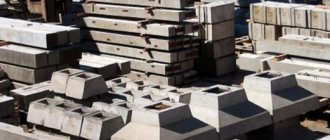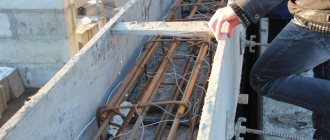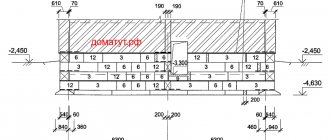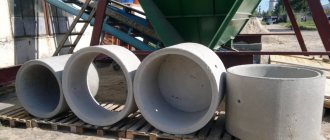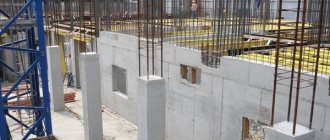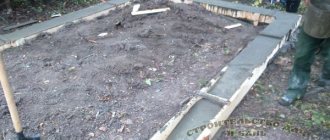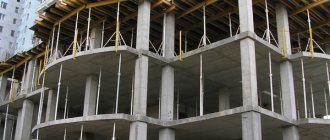Pouring concrete in winter has its own difficulties. The main problem is the normal hardening of the solution, the water in which can freeze and it will not gain technological strength. Even if this does not happen, the low drying rate of the composition will make the work unprofitable. Warming up the concrete with a PNSV wire will help resolve this issue.
Electric heating of concrete in winter is the most convenient and cheapest way to achieve the desired hardness of the material. It is permitted by the standards of SP 70.13330.2012, and can be used when performing any construction work. After the concrete hardens, the wire remains inside the structure, so the use of cheap PNSV provides an additional economic effect.
Application
Warming up concrete in winter with a cable makes it possible to solve two main problems. At temperatures below zero, the water in the solution turns into ice crystals, and as a result, the cement hydration reaction not only slows down, it stops completely. It is known that when water freezes, it expands, destroying the bonds formed in the solution, so after increasing the temperature it will no longer gain the required strength.
The solution hardens at optimal speed and maintains characteristics at a temperature of about 20°C. As temperatures drop, especially below freezing, these processes slow down, even though hydration produces additional heat. In order to meet technical conditions, in winter it is impossible to do without heating the concrete with a PNSV wire or another cable intended for this purpose in situations where:
- sufficient thermal insulation of the monolith and formwork is not provided;
- the monolith is too massive, which makes it difficult to heat it evenly;
- low ambient temperature at which water in solution freezes.
Infrared heating of concrete
Infrared heating of concrete involves the use of thermal energy released by infrared emitters, directed at the open or formwork surfaces of heated structures.
The scope of application of infrared heating of monolithic structures in the production of concrete and reinforced concrete works at negative outdoor temperatures includes:
- heating frozen concrete and soil foundations, reinforcement, embedded parts and formwork, removing snow and ice;
- intensification of concrete hardening of monolithic structures and structures erected in sliding or volumetric-adjustable formwork, floor slabs and coatings, vertical and inclined structures concreted in metal or structural formwork;
- pre-heating of the joint zone of prefabricated reinforced concrete structures and acceleration of hardening of concrete or mortar when sealing joints;
- creation of thermal protection of surfaces inaccessible for insulation.
Wire characteristics
The cable for heating concrete PNSV consists of a steel core with a cross-section from 0.6 to 4 mm², and a diameter from 1.2 mm to 3 mm. Some types are galvanized to reduce the impact of aggressive components in mortars. Additionally, it is covered with heat-resistant polyvinyl chloride (PVC) or polyester insulation; it is not afraid of kinks, abrasion, aggressive environments, is durable and has high resistivity. The PNSV cable has the following technical characteristics:
- The resistivity is 0.15 Ohm/m;
- Stable operation in the temperature range from -60°C to +50°C;
- Up to 60 m of wire is consumed per 1 cubic meter of concrete;
- Can be used at temperatures down to -25°C;
- Installation at temperatures down to -15°C.
The cable is connected to the cold ends through an aluminum autorecloser wire. Power can be supplied via a three-phase 380 V network by connecting to a transformer. With proper calculation, the PNSV can also be connected to a 220-volt household network; the length should not be less than 120 m. An operating current of 14-16 A should flow through the system located in the concrete mass.
Induction heating of concrete
Induction heating of monolithic structures allows the use of the magnetic component of an alternating electromagnetic field for the thermal effect of electric current induced by electromagnetic induction. During induction heating of monolithic structures, the energy of an alternating magnetic field is converted into heat in the reinforcement or steel formwork and transferred to the concrete by thermal conductivity. Induction heating of concrete is applicable to closed-loop structures whose length exceeds the cross-sectional dimensions, with dense reinforcement with a reinforcement coefficient of more than 0.5, when concreting which it is possible to wrap them with a cable (make an inductor) or when concreting is carried out in metal formwork.
Heating technology and laying scheme
Before installing the concrete heating system in winter, formwork and reinforcement are installed. After this, the PNSV is laid out with an interval between the wires of 8 to 20 cm, depending on the outside temperature, wind and humidity. The wire is not stretched and is attached to the fittings with special clamps. Bends with a radius of less than 25 cm and overlaps of current-carrying conductors should not be allowed. The minimum distance between them should be 1.5 cm, this will help prevent short circuits.
The most popular installation scheme for PNSV is a “snake”, reminiscent of a “warm floor” system. It provides heating of the maximum volume of concrete mass while saving heating cable. Before pouring the solution into the formwork, you must make sure that there is no ice in it, the temperature of the mixture is not lower than +5°C, and the installation of the connection diagram is carried out correctly, and the cold ends are brought out to a sufficient length.
The PNSV wire comes with instructions, which you need to read before heating the concrete. The connection is made through sections of busbars in two ways through a “triangle” or “star” circuit. In the first case, the system is divided into three parallel sections connected to the terminals of a three-phase step-down transformer. In the second, three identical wires are connected into one node, then three free contacts are similarly connected to the transformer. The power supply is installed no further than 25 m from the connection point, the heated area is surrounded by a fence. The system is connected after the entire volume of mortar has been completely filled. The technology for heating concrete with a PNSV heating cable includes several stages:
- Heating is carried out at a rate of no more than 10°C per hour, which ensures uniform heating of the entire volume.
- Heating at a constant temperature continues until the concrete reaches half its technological strength. The temperature should not exceed 80°C, the optimum is 60°C.
- Cooling of the concrete should occur at a rate of 5°C per hour, this will help avoid cracking of the mass and ensure its solidity.
If the technological requirements are met, the material will gain a grade of strength corresponding to its composition. At the end of the work, the PNSV remains in the thickness of the concrete and serves as an additional reinforcing element.
It should be noted that using a KDBS or VET cable is much easier, since they can be connected directly to a 220 V network through a panel or socket. They are divided into sections, which helps to avoid overload. But these cables are more expensive than PNSV, so they are less often used in the construction of large facilities.
Another popular technology is the use of formwork with heating elements and electrodes, when the reinforcement is inserted into the solution and connected to the network using a welding machine or another type of step-down transformer. This heating method does not require a special heating cable, but is more energy-consuming, since water in concrete acts as a conductor, and its resistance increases significantly during hardening.
Length calculation
To calculate the length of the PNSV wire for heating concrete, several main factors must be taken into account. The main criterion is the amount of heat supplied to the monolith for its normal hardening. It depends on the ambient temperature, humidity, the presence of thermal insulation, volume and shape of the structure.
Depending on the temperature, the cable laying pitch is determined with an average loop length of 28 to 36 m. At temperatures down to -5°C, the distance between the cores or pitch is 20 cm, with a decrease in temperature for every 5 degrees, it decreases by 4 cm, at - At 15°C it is 12 cm.
When calculating the length, it is important to know the power consumption of the PNSV heating wire. For the most popular diameter of 1.2 mm, it is equal to 0.15 Ohm/m; for wires with a large cross-section, the resistance below a diameter of 2 mm has a resistance of 0.044 Ohm/m, and 3 mm – 0.02 Ohm/m. The operating current in the core should be no more than 16 A, therefore the power consumption of one meter of PNSV with a diameter of 1.2 mm is equal to the square of the current and the resistivity and is 38.4 W. To calculate the total power, you need to multiply this figure by the length of the laid wire.
The voltage of the step-down transformer is calculated in a similar way. If 100 m of PNSV with a diameter of 1.2 mm are laid, then its total resistance will be 15 Ohms. Considering that the current is no more than 16 A, we find the operating voltage equal to the product of the current and the resistance; in this case it will be equal to 240 V.
The use of PNSV wire is one of the cheapest ways to heat concrete. But it is more suitable for use by professional builders, since its connection requires special knowledge and equipment. This cable can also be used at home if you correctly calculate the power consumption. The use of thermal insulation materials will help reduce costs when heating the solution; in this case, heating will occur faster, and the temperature decrease will occur more evenly, which will improve the quality of concrete.
Why is it necessary to warm up concrete in winter?
SP 70.13330 states that concreting work at average daily outside air temperatures below +5° C or at a minimum daily air temperature below 0° C is considered winter concreting.
Why do these temperatures stand out?
The main component of concrete is cement. It is also called astringent.
Cement is a water-hardening binder. This means that in order to obtain a hard and durable concrete stone, it is necessary for the cement components to enter into chemical reactions with water, the so-called hydration reactions.
From the outside it seems that the cement was simply mixed with water and aggregates and dried, but this is not so. When cement components, such as alit, belite, tricalcium aluminate and tetracalcium aluminoferrite, react, new compounds with a crystalline structure are formed.
Hydration processes take time; allite, ferrite and aluminate phases react quickly, belite reacts more slowly. A total of 28 days are needed for the concrete to reach its design strength.
Important!
The critical strength of concrete is also distinguished. This is strength, upon reaching which concrete is no longer afraid of unfavorable environmental conditions; usually this is 30-50% of the design strength.
The optimal conditions for concrete hardening are:
- outside air temperature 18-20° C;
- high air humidity.
What happens if the air temperature drops below?
As the temperature decreases, chemical reaction processes slow down more and more.
Subsequently, if the concrete is heated, it will gain strength, but it will be lower than expected.
If the air temperature drops to 0° C or lower, the water that has not had time to react with the cement components will freeze. When it freezes, it will expand and lead to the formation of voids and cracks in the concrete, which will negatively affect the strength of the finished product. The formation of an ice film around the reinforcement will contribute to its peeling.
Since the amount of water in the concrete mixture is calculated in advance, the cement components will not have enough water to react, thus hydration will not take place completely, and this will reduce the strength of the concrete.
That is why, when concreting in winter, certain measures should be taken to ensure the correct occurrence of hydration reactions.
These measures are divided into three types:
- adding special components to the concrete solution;
- heat preservation;
- heating the concrete.
Each of these activities has its pros and cons. The decision is made based on the specific situation.
There are certain standards for carrying out any warming activities that allow them to be carried out most efficiently and economically. They are reflected in technological maps.
The use of special additives for concrete solutions.
Antifreeze additives increase the rate of reactions and at the same time reduce the pour point of water in the mixture, due to which concrete hardens even at low temperatures.
Hardening accelerator additives contribute to the rapid development of critical strength, after which the concrete is no longer afraid of the cold.
The simplest option for antifreeze additives is chloride salts, but their use has many limitations, since they are not compatible with any type of Portland cement and only work up to a temperature of –10°C; in addition, they are not recommended for use in reinforced structures, since they can cause corrosion fittings.
Another thing is special additives, for example, CemFrio and HotIce from CEMMIX.
These supplements have many benefits:
- low dosages;
- simple adding procedure;
- efficient operation down to a temperature of –20° C without warming up;
- additional plasticizing effect, allowing to obtain mixtures with increased workability;
- preventing mixture separation;
- good compatibility with all types of cements and reinforcement;
- saving cement and water;
- increasing the strength of the finished product.
Heat preservation
When hydration reactions occur in the concrete mixture, heat is released. If the poured structure is large and thick enough, enough heat is generated to prevent the concrete from freezing. You just need to save it.
For this purpose, the thermos method is used:
- Concrete is mixed from heated materials. Cement cannot be heated to avoid “cooking”, but aggregates, reinforcement and formwork are heated with hot air, water is heated to a temperature of 70° C.
- Insulated formwork is used.
- After laying the concrete mixture, its temperature should not be lower than +10° C.
- The filling is covered with heat-insulating materials. Sometimes special heating mats are used.
- Peripheral parts of structures can be additionally heated by electrodes.
- Additionally, antifreeze additives are used for concrete.
The thermos method is effective for large structures, but it is not enough if the pour has a large cooling area or the temperatures are too low (below -10° C).
Warming up the concrete
There are several ways to heat concrete:
- warm houses;
- electrode heating;
- infrared heating;
- induction heating;
- thermomats;
- heating of concrete using PNSV.
Teplyaki
Teplyaks are a kind of “tents” that are erected over a concrete pour. Heat guns are installed inside to maintain the temperature at the desired level. Once the structure reaches critical strength, the tents can be dismantled.
Electrode heating
Electrodes are fixed inside the formwork, so that current can be passed through the concrete solution and thus heat the concrete.
The technological map for electrode heating of monolithic concrete structures contains organizational and technical solutions for electrode heating of concrete in order to speed up work and improve the quality of structures that are manufactured in the cold season.
These solutions are developed in accordance with the requirements of SNiP. You can find out more about them in SP 70.13330.2012 “Load-bearing and enclosing structures”, clause 5.11 “Concrete work at sub-zero temperatures”.
The card regulates:
- scope of application of electrode heating (through, peripheral, reinforcing) with diagrams and instructions on the preparation of structures;
- admissibility of the use of antifreeze additives, their type and quantity;
- scope of application of hydrothermal insulation;
- methods and work schedule;
- labor cost calculation;
- warm-up parameters;
- necessary material and technical resources;
- safety precautions;
- requirements for quality and acceptance of work;
- technical and economic indicators.
The technological map allows you to correctly and timely carry out all the necessary work on electrode heating of concrete structures in winter.
Infrared heating
Concrete is heated with infrared radiation.
Induction heating
It warms up the reinforcement, which also warms up the concrete.
Thermomat
Heaters are laid out in the form of mats on the pouring surface. They heat the concrete evenly.
Heating concrete using PNSV (heating wire with a steel core and insulation made of polyethylene or polyvinyl chloride plastic)
The PNVS wire is deciphered as follows:
- P - wire;
- H - heating;
- C - wire material (steel);
- B - insulation material (vinyl, which is more correctly called polyvinyl chloride).
The wire is immersed in concrete; Check the voltage in the circuit at least twice per shift.
The technological map for electrical heating of monolithic structures with heating wires contains instructions for electrical heating of structures using PNSV. In it you can find information regarding the scope of application of the method, organization and technology of work, and acceptance requirements.
Important!
When choosing any heating method, additional use of antifreeze additives will be advisable. All warm-up methods are expensive, so the sooner they can be stopped, the more money will be saved. Additives that accelerate hardening and antifreeze additives allow concrete to quickly reach critical strength, after which warming up measures can be canceled.
We advise you to study: Additives for concrete
